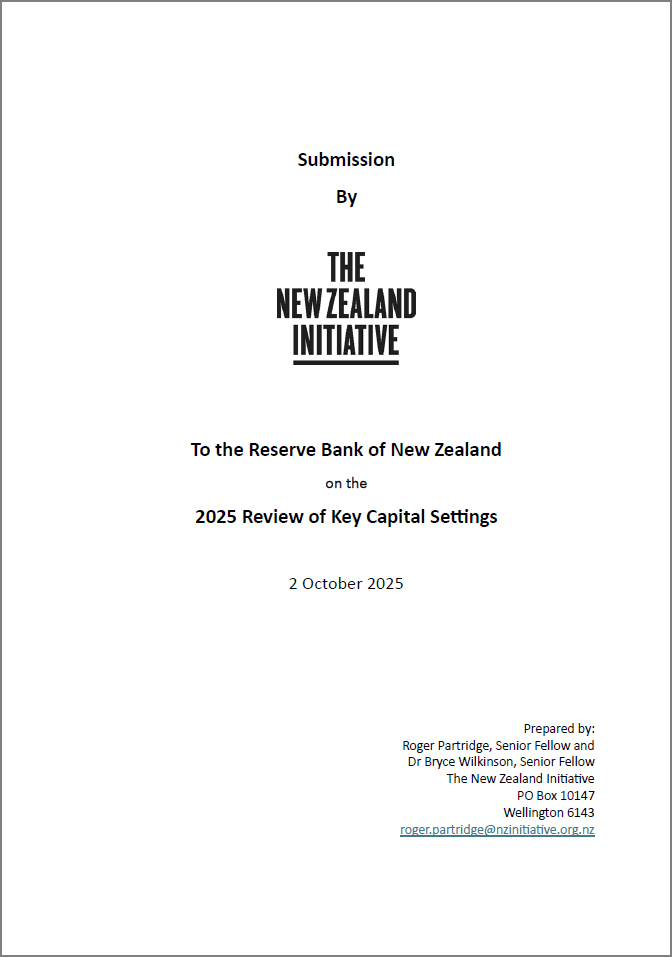1. INTRODUCTION AND RECOMMENDATIONS
1.1 This submission to the Reserve Bank of New Zealand (RBNZ) on its 2025 Review of Bank Capital Requirements (the Review) and accompanying consultation paper (the Consultation paper)1 is made by The New Zealand Initiative, an independent think tank supported primarily by major New Zealand businesses. In combination, our members employ more than 150,000 people across the economy.
1.2 The Initiative undertakes research that contributes to the development of sound public policy and the creation of a competitive, open and dynamic economy and a free, prosperous, fair and cohesive society.
1.3 The Initiative’s members span the breadth of the New Zealand economy, including banks and companies that use banking services. However, the views expressed in this submission are the views of the authors, not those of our members.
1.4 This submission focuses primarily on the four major New Zealand banks (ANZ, ASB, BNZ, Westpac) – classified as “Domestic Systemically Important Banks” (or D-SIBs) because these banks are systemically important, hold the majority of banking assets, and are the primary users of the Internal Ratings-Based (IRB) models most affected by the RBNZ’s conservative capital overlays.
1.5 In summary, we submit:
(a) Efficiency should be the overriding test: Financial stability – or “prudential regulatory” – settings exist to make New Zealanders better off, not as ends in themselves. They must pass an efficiency test: benefits to the community must exceed the costs. Without this discipline, regulations become “gold-plating” that harms the very people they aim to protect through higher borrowing costs and constrained credit. The large banks themselves are, in our view, relatively impervious to whatever prudential regulatory settings are imposed. They will adapt and continue to operate profitably. Our concern is not the impact of prudential regulatory settings on the banks themselves, but rather the flow-through effects on New Zealand borrowers, businesses, and the broader economy. Higher-than-necessary capital requirements translate directly into higher borrowing costs for households and businesses, reduced credit availability for productive investment, and slower economic growth. The ultimate question is therefore not whether banks can cope with conservative regulatory settings, but whether such settings serve New Zealanders’ economic interests.
(b) The RBNZ’s 2019 bank capital decision lacked adequate justification: As we explained in our 2024 submission to the Finance and Expenditure Select Committee inquiry on Banking Competition (our FEC Submission),2 we have doubts about whether the RBNZ’s December 2019 bank capital decision (the 2019 Decision)3 can be justified on efficiency grounds. The RBNZ acknowledged the decision would raise lending rates ~30 basis points and reduce GDP by up to 0.32% annually. Independent analysts suggested the GDP impact could be closer to 1%. More broadly, analysts suggest that New Zealand’s cumulative prudential regulatory burden may be costing the economy up to 2% of GDP, equivalent to approximately $10 billion annually.4 The RBNZ provided a cost-benefit analysis to support its case. However, as we explained in our FEC submission, the RBNZ’s assumed values for important parameters are not robustly estimated.5 We do not believe that the RBNZ is in a position to be confident enough for regulatory policy purposes that the long-term benefits to financial stability of its 2019 Decision outweigh these substantial economic costs.
(c) New Zealand’s prudential regulatory settings depart materially from international norms: Oliver Wyman, the international consulting firm commissioned by the RBNZ for this review, shows under current settings that our major banks currently hold capital buffers of around 21% Common Equity Tier 1 capital (CET1) compared with 13-19% for many peer countries, and 18.3% for Australia.6 When the RBNZ’s 2019 Decision is fully implemented in 2028, Oliver Wyman estimates this 21% requirement will reach 25%. The differences between the RBNZ’s settings and international peers reflect regulatory framework variations rather than different portfolio mixes. Requiring each loan by a New Zealand bank to be backed by more capital than in peer countries means higher funding costs for banks, which translates directly into higher interest rates for New Zealand borrowers and less credit availability.
(d) The proposals in the Consultation paper show progress but stop short of a genuine reset: The Consultation paper puts forward two proposals to adjust bank capital requirements compared with the 2019 Decision: Option 1 and Option 2. Yet both options maintain New Zealand as an international outlier through the persistence of conservative calculation methodologies. The most significant of these is the 85% output floor discussed in section 4, compared with a lower 72.5% international standard. However, given the fundamental flaws in the RBNZ’s analytical framework identified throughout this submission, these modelling results cannot be relied upon to determine optimal settings.
(e) Any departure from international norms requires rigorous justification: If the RBNZ’s own analysis shows such substantial benefits from partial alignment, the burden of proof is on explaining why complete international alignment should not be pursued. The consultation fails to provide this justification, instead relying on the same flawed analytical framework from the 2019 Decision. A rigorous, independently peer-reviewed cost-benefit analysis should include an assessment of full international alignment, not just the limited options presented. Any such analysis will necessarily be imperfect given the knowledge limitations inherent in complex regulatory decision-making, but this makes transparency and independent scrutiny even more essential.
(f) Implementation of the December 2019 decision should be paused pending proper reassessment: The timing of this Review is unfortunate. The RBNZ released the Consultation paper just days after the Finance and Expenditure Committee published its report recommending an independent review of the December 2019 decision. Rather than rushing ahead with a consultation that uses the same over-simplified analytical framework, implementation of the remaining 2019 increases should be paused pending a comprehensive, independent reassessment of the prudential regulatory settings.
1.6 We expand on these points in the sections that follow.





